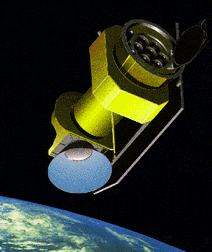ABRIXAS

ABRIXAS (A Broad-band Imaging X-ray All-sky
Survey Satellite) was the planned follow-on to ROSAT. It was
successfully launched on April 28, 1999, from the Russian launch center
at Kapustin Yar into an orbit with a 580 km altitude and a 51°
inclination. The initial mission operations was to last for three years.
However, a few days after launch, ABRIXAS experienced problems with its
battery, and attempts to bypass the problem by using the solar arrays
were not successful. On April 30, the ground station lost cantact
and the mission was ultimately abandoned without acquiring any science data
after some further attempts to
establish communications and control. The satellite re-entered the
Earth’s atmosphere on October 31, 2017.
Its primary mission was to map the entire sky with its imaging telescope
in the energy range 0.5–10 keV.
This project was a collaboration of the Astrophysical Institute Potsdam
(AIP), the Max-Planck-Institut for Extraterrestrial Physics (MPE), and the
Institute for Astronomy and Astrophysics of the University of Tübingen
(IAAT). The German Space Agency, DARA, was responsible for project
management.
ABRIXAS carried seven nested Wolter-1 type grazing incident telescopes
with 27 mirror elements in each telescope. The telescopes had a focal length of
1.6 meters. Each had a pn-CCD with a 6 x 6 cm2 detector modeled
on the EPIC camera used in the Newton-XMM mission, and had high efficiency
and good spectral resolution.
The early mission failure of the battery system occured before science
data could be collected. Had this not occurred, the three year mission plan
would have performed an all-sky survey with an anticipated detection of at
least 10,000 new hard X-ray sources obscured by gas and dust at lower energy
levels, collected data on diffuse X-ray sources, and measured bright
time-variable X-ray sources.
[ABRIXAS MPE] http://wave.xray.mpe.mpg.de/abrixas/ no longer online
[All Missions]
[by Time]
[by Energy]
Page authors: Lorella Angelini Jesse Allen
HEASARC Home |
Observatories |
Archive |
Calibration |
Software |
Tools |
Students/Teachers/Public
Last modified: Thursday, 24-Sep-2020 17:21:49 EDT
|